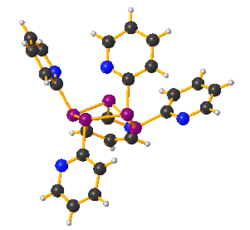Chemistry:Cyclopentaphosphine

| |
| Names | |
|---|---|
| IUPAC name
pentaphospholane
| |
| Other names
Cyclopentaphosphane, pentaphosphole
| |
| Identifiers | |
3D model (JSmol)
|
|
| ChemSpider | |
| EC Number |
|
PubChem CID
|
|
| |
| |
| Properties | |
| H5P5 | |
| Molar mass | 159.909 g/mol |
Except where otherwise noted, data are given for materials in their standard state (at 25 °C [77 °F], 100 kPa). | |
| Infobox references | |
Cyclopentaphosphine is the inorganic compound with the formula (PH)5. It is prepared by the hydrolysis of cyclo-[PSiMe3]4 (Me = methyl). Although only of theoretical interest, (PH)5 is parent of many related cyclic polyphosphines that are the subject of research.
Organic cyclophosphines

Organic cyclophosphanes are a family of organophosphorus compounds with the formula (RP)n where R is an organic substituent. Many examples are known. They are white, air-sensitive solids with have good solubility in organic solvents. Well-characterized examples are known for ring sizes 3–6. The three-membered rings feature bulky substituents, e.g., [tert-BuP]3.
The cyclophosphines can be prepared by several methods, one involves reductive coupling of dichlorophosphines:[2]
- 5 PhPCl2 + 5 Mg → [PhP]5 + 5 MgCl2
Isomerism
The structures are complicated by the slow pyramidal inversion at phosphorus(III). In principle, many isomers are possible for cyclo-P5R5, but usually only one is observed.[3] All phenyl substituents are equatorial in cyclo-P6(C6H5)6.[4]
References
- ↑ Schoemaker, Robin; Schwedtmann, Kai; Franconetti, Antonio; Frontera, Antonio; Hennersdorf, Felix; Weigand, Jan J. (2019). "Controlled Scrambling Reactions to Polyphosphanes via Bond Metathesis Reactions". Chemical Science 10 (48): 11054–11063. doi:10.1039/C9SC04501E. PMID 32190255.
- ↑ Marianne Baudler, Klaus Glinka (1993). "Monocyclic and Polycyclic Phosphines". Chem. Rev. 93: 1623–1667. doi:10.1021/cr00020a010.
- ↑ Hoffman, P. R.; Caulton, K. G. (1975). "Conformational Stability and Ring-Size Integrity of Cyclic Polyphosphines". Inorganic Chemistry 14 (8): 1997–1999. doi:10.1021/ic50150a051.
- ↑ Schmutzler, Reinhard; Heuer, Lutz; Schomburg, Dietmar (1993). "Transformations of Difluorophosphines: The Influence of Solvent on the Reaction Pathway and Ring Size in Cyclopolyphosphines". Phosphorus, Sulfur, and Silicon and the Related Elements 83 (1–4): 149–156. doi:10.1080/10426509308034357.
 |

